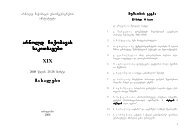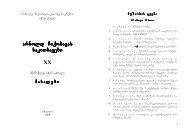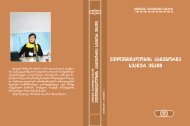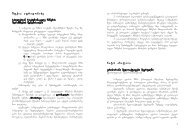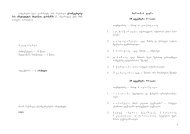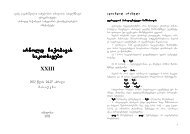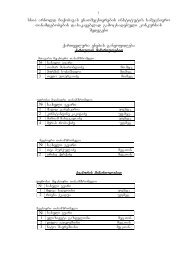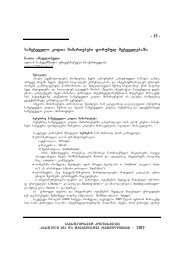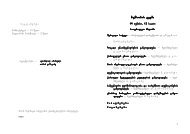5 r. a b a S i a (Tbilisi) bgeraTSesatyvisobis erTi rigisaTvis qarTvelur ...
5 r. a b a S i a (Tbilisi) bgeraTSesatyvisobis erTi rigisaTvis qarTvelur ...
5 r. a b a S i a (Tbilisi) bgeraTSesatyvisobis erTi rigisaTvis qarTvelur ...
Create successful ePaper yourself
Turn your PDF publications into a flip-book with our unique Google optimized e-Paper software.
N. D a t e s h i d z e (<strong>Tbilisi</strong>)<br />
Affixoids’ Word Formation Means in Terminology<br />
1. Scientific and technical language, on various stages of its historical development,<br />
always tried to create terms, which would exactly describe the meaning<br />
of the notion. Just the necessity of exact coincidence between the term and<br />
the notion activated in the language the process of landing, which is one of the<br />
ways of enriching a lexical stock. The trend of scientific language, directed towards<br />
internationalization, even more facilitated creation of common terms for<br />
various languages – the so-called internationalisms. Terms of foreign origin are<br />
confirmed in a lot of languages. In the result of their morphological division<br />
their stems, derivation affixes, having identical functional-semantic loading could<br />
be marked out. In special literature they are generally called term-elements. A<br />
term-element can be of pure affix origin, like –ad (brig-ade), -ex (refl-ex,<br />
compl-ex), -od (coth-ode, electr-ode), -ose (visc-ose, nitr-ose)… , also the stem<br />
of fully meaningful word, which is the constituent component of a compound<br />
word: micro-phone, motor-cade, etc. Term-elements are extensively used for<br />
formation of terms, so their special study is one of the topical issues.<br />
2. Affixoids come from Greek-Latin languages and root themselves in<br />
modern language in the form of structural elements. They reoccur in compound<br />
words with one and the same meaning and approach to affixes by their function,<br />
creating certain terminological forms.<br />
Significant part of affixoids in the source language was independent,<br />
meaningful words. Genetically they still relate to the relevant Greek and Latin<br />
stems and maintain the same semantics, which they had in the language of their<br />
origin: nouns: logos – word, gramma- record; adjectives: micros – small; themos<br />
– warm; prefixes: para - near; outside, outer; hipo – beneath, under; anti –<br />
instead, against, etc. While becoming terms, they lose the function of the parts<br />
of speech, turn into elements of compound words and obtain special terminological<br />
meaning.<br />
3. Affixoids have significant function in scientific language. They define<br />
semantic transparency and motivatedness. Poly-semousness of words existing in<br />
literary language, which represents one of the means of enriching a lexical<br />
stock, breaks one-sided relation between a term and a notion in terminology, its<br />
140



